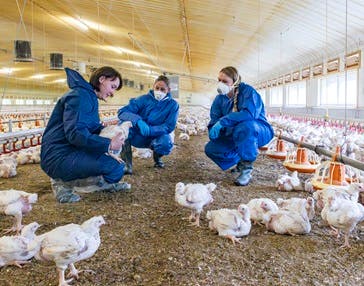What is footpad dermatitis in poultry?
Footpad dermatitis is one of the most common leg health issues that can affect broiler flocks1, and is a key indicator of bird welfare standards on-farm.
Research shows that, despite feed efficiency improvements, faster-growing broiler breeds may be at greater risk of leg disorders, such as footpad dermatitis2.
This not only affects bird welfare, but can also result in productivity losses for poultry producers.
So, to help protect leg health in broilers for optimal welfare and productivity, this article outlines the causes of footpad dermatitis, its impacts, and practical steps for prevention.
What is footpad dermatitis?
Footpad dermatitis is a condition characterised by necrotic lesions on the underside of a bird's footpads.
These lesions may start as minor discolouration or dark marks and can progress to painful, deep ulcers.
In severe cases, they may cause significant discomfort, impaired movement, and act as entry points for secondary infections - all of which negatively impact broiler welfare, health, and overall performance1.
If present, the severity of footpad dermatitis can be assessed from 0 to 2 using the Swedish footpad scoring system, as shown in the table below.

Score | Description |
0 | No lesions or very small superficial ones, with slight discolouration limited to a small area of the footpad, mild thickening of the outer skin layer (hyperkeratosis), or evidence of a healed lesion. |
1 | Mild lesions present, including discolouration of the footpad, superficial damage, darkened papillae, and notable hyperkeratosis. |
2 | Severe lesions observed, where the epidermis is damaged, with ulcers or scabs, signs of bleeding, or swollen footpads. |
Causes of footpad dermatitis
Footpad dermatitis is a multifactorial condition influenced by management, nutrition, and the physiological state of birds.
Key factors include:
1. Wet and poor quality litter
Litter with a moisture content exceeding 30% is highly conducive to the development of footpad dermatitis1.
Wet litter can arise from:
- Poor ventilation, leading to inadequate drying of droppings
- High humidity levels in the poultry house
- Spillage from water systems
- Excessively high stocking densities, increasing manure concentration in confined areas
2. Intestinal health and dropping consistency
Poor Intestinal Integrity in poultry often correlates with loose droppings.
Conditions like coccidiosis, necrotic enteritis, and gut dysbiosis in chickens create a cycle of poor intestinal health leading to wet droppings, which in turn leads to increased litter moisture levels.
High litter moisture weakens footpad skin integrity and encourages the development of footpad dermatitis, making intestinal health management a critical factor in preventing this issue5,6,7.
Impacts of footpad dermatitis for poultry producers
Footpad dermatitis can impose several negative impacts on poultry flocks and producers.
Principally, there is the bird welfare concern - severe footpad lesions cause pain, reduced mobility, and increased susceptibility to systemic infections.
The knock-on effect of this is a reduced feed conversion ratio (FCR). Birds suffering from footpad dermatitis show impaired mobility, reducing feed and water intake, which negatively impacts broiler growth performance1.
Footpad lesions may also lead to downgrades or condemnation of affected carcasses at slaughter4.
Treating footpad dermatitis issues in affected birds comes at a cost too – so prevention is key.
How to prevent footpad dermatitis in poultry
To effectively prevent footpad dermatitis, it is essential to address the underlying causes and minimise contributing risk factors.
Maintaining dry and high-quality litter is crucial for preventing footpad dermatitis, which can be achieved by using absorbent materials, like wood shavings, replacing wet or compacted litter promptly, and optimising ventilation to control humidity.
Monitoring tools
Tools like Elanco’s Health Tracking System, HTSi, enable poultry producers to closely monitor flock health.
This includes analysing Intestinal Integrity and locomotor health to identify early risk factors for, and the severity of incidences of, footpad dermatitis.
Our knowledgeable HTSi team conduct farm visits, offering tailored recommendations to combat gut health issues such as coccidiosis, to help prevent associated challenges, including footpad dermatitis and hock burn.
- Dawkins, M.S., Roberts, S.J., Cain, R.J., Nickson, T. and Donnelly, C.A., 2017. Early warning of footpad dermatitis and hockburn in broiler chicken flocks using optical flow, bodyweight and water consumption. Veterinary record, 180(20), pp.499- 499.
- Knowles, T.G., Kestin, S.C., Haslam, S.M., Brown, S.N., Green, L.E., Butterworth, A., Pope, S.J., Pfeiffer, D. and Nicol, C.J., 2008. Leg disorders in broiler chickens: prevalence, risk factors and prevention. PloS one, 3(2), p.e1545.
- De Jong, I.C., Van Harn, J., Gunnink, H., Hindle, V.A. and Lourens, A., 2012. Footpad dermatitis in Dutch broiler flocks: Prevalence and factors of influence. Poultry science, 91(7), pp.1569-1574.
- Shepherd, E.M. and Fairchild, B.D., 2010. Footpad dermatitis in poultry. Poultry science, 89(10), pp.2043-2051.
- Clave H et al Sci Tech Avicoles 2004
- Ruff, MD, et al. (1980) Anticoccidial activity of Narasin in broiler chickens reared in floor pens. Poultry Sci; 59:2008-2013
- HTSi Data EMEA region 2010-2016
- Abd El-Wahab, A., Kriewitz, J.P., Hankel, J., Chuppava, B., Ratert, C., Taube, V., Visscher, C. and Kamphues, J., 2020. The effects of feed particle size and floor type on the growth performance, GIT development, and pododermatitis in broiler chickens. Animals, 10(8), p.1256.